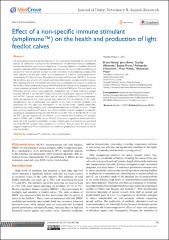Effect of a Non-Specific Immune Stimulant (Amplimune™) on the Health and Production of Light Feedlot Calves

View/
Date
2017Author
Nosky, Bruce
Biwer, Jerry
Alkemade, Stanley
Prunić, Bojana
Milovanović, Aleksandar
Maletić, Milan
Mašić, Aleksandar
Metadata
Show full item recordAbstract
An increasing concern from both producers and consumers regarding the overuse and misuse of antibiotics leading to the development of antibiotic-resistant pathogens dictates the need for new research objectives. These new objectives should be directed towards exploring different management practices and the use of antibiotic alternative products to treat or prevent disease in cattle and other food producing animals. The main objective of this pilot study was to determine if a bovine immunotherapeutic (Amplimune™) derived from Mycobacterium cell wall fraction (MCWF) decreases the incidence and severity of clinical conditions that require antimicrobial treatments, thus reducing the cost of treatment and improving weight gain in young calves entering the feedlot. Four hundred and eighty (480) Holstein steer calves were transported from a large commercial ranch in New Mexico to a feedlot in California. Twenty-four hours following arrival, calves were randomly assigned to one of three treatment groups (control, MCWF 1 and MCWF 3) and allocated to feedlot pens. Animals in MCWF 1 and MCWF 3 groups received either 1mL or 3mL of Amplimune™ subcutaneously, while the animals in the control group were untreated. For the purpose of the study, metaphylactic use of antibiotics was omitted at the time of arrival. Animals were monitored for 102 days and information on the health status, clinical conditions, treatments and body weights were collected and subjected to further analysis. Groups that received Amplimune™ had 13 and 39 less treated animals compared to controls, resulting in calculated savings of USD 535.84 and USD 1021.36 for the MCWF 1 and MCWF 3 groups respectively. In addition, calves treated with Amplimune™ gained a total of 580lbs. and 1,630lbs. more. Overall, there was a significant beneficial effect observed with regards to morbidity, average weight gain, and medical cost per head for both MCWF groups when compared to controls. Results from this pilot study suggest Amplimune™ as a substitute for antibiotic prophylactic treatment in calves entering feedlot.
